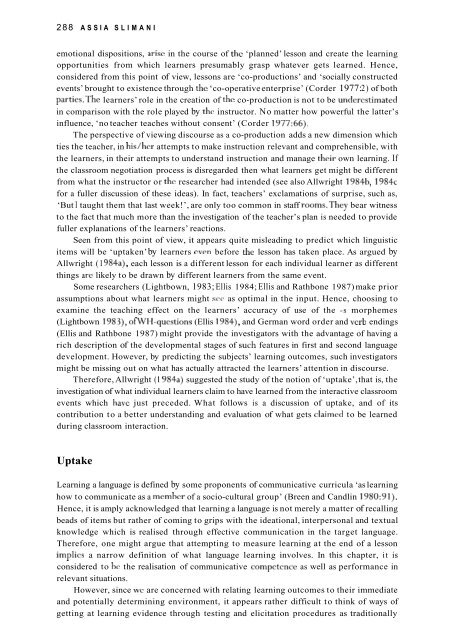English Language Teaching in its Social Context
English Language Teaching in its Social Context
English Language Teaching in its Social Context
You also want an ePaper? Increase the reach of your titles
YUMPU automatically turns print PDFs into web optimized ePapers that Google loves.
288 ASSIA SLIMANIemotional dispositions, arise <strong>in</strong> the course of the ‘planned’ lesson and create the learn<strong>in</strong>gopportunities from which learners presumably grasp whatever gets learned. Hence,considered from this po<strong>in</strong>t of view, lessons are ‘co-productions’ and ‘socially constructedevents’ brought to existence through the ‘co-operative enterprise’ (Corder 1977: 2) of bothparties.The learners’ role <strong>in</strong> the creation of the co-production is not to be underestimated<strong>in</strong> comparison with the role played by the <strong>in</strong>structor. No matter how powerful the latter’s<strong>in</strong>fluence, ‘no teacher teaches without consent’ (Corder 1977:66).The perspective of view<strong>in</strong>g discourse as a co-production adds a new dimension whichties the teacher, <strong>in</strong> his/her attempts to make <strong>in</strong>struction relevant and comprehensible, withthe learners, <strong>in</strong> their attempts to understand <strong>in</strong>struction and manage their own learn<strong>in</strong>g. Ifthe classroom negotiation process is disregarded then what learners get might be differentfrom what the <strong>in</strong>structor or the researcher had <strong>in</strong>tended (see also Allwright 1984b, 1984cfor a fuller discussion of these ideas). In fact, teachers’ exclamations of surprise, such as,‘But I taught them that last week!’, are only too common <strong>in</strong> staff rooms.They bear witnessto the fact that much more than the <strong>in</strong>vestigation of the teacher’s plan is needed to providefuller explanations of the learners’ reactions.Seen from this po<strong>in</strong>t of view, it appears quite mislead<strong>in</strong>g to predict which l<strong>in</strong>guisticitems will be ‘uptaken’ by learners even before the lesson has taken place. As argued byAllwright (1 984a), each lesson is a different lesson for each <strong>in</strong>dividual learner as differentth<strong>in</strong>gs arc likely to be drawn by different learners from the same event.Some researchers (Lightbown, 1983; Ellis 1984; Ellis and Rathbone 1987) make priorassumptions about what learners might see as optimal <strong>in</strong> the <strong>in</strong>put. Hence, choos<strong>in</strong>g toexam<strong>in</strong>e the teach<strong>in</strong>g effect on the learners’ accuracy of use of the -s morphemes(Lightbown 1983), ofWH-questions (Ellis 1984), and German word order and verb end<strong>in</strong>gs(Ellis and Rathbone 1987) might provide the <strong>in</strong>vestigators with the advantage of hav<strong>in</strong>g arich description of the developmental stages of such features <strong>in</strong> first and second languagedevelopment. However, by predict<strong>in</strong>g the subjects’ learn<strong>in</strong>g outcomes, such <strong>in</strong>vestigatorsmight be miss<strong>in</strong>g out on what has actually attracted the learners’ attention <strong>in</strong> discourse.Therefore, Allwright ( 1 984a) suggested the study of the notion of ‘uptake’, that is, the<strong>in</strong>vestigation of what <strong>in</strong>dividual learners claim to have learned from the <strong>in</strong>teractive classroomevents which have just preceded. What follows is a discussion of uptake, and of <strong>its</strong>contribution to a better understand<strong>in</strong>g and evaluation of what gets claimed to be learneddur<strong>in</strong>g classroom <strong>in</strong>teraction.UptakeLearn<strong>in</strong>g a language is def<strong>in</strong>ed by some proponents of communicative curricula ‘as learn<strong>in</strong>ghow to communicate as a member of a socio-cultural group’ (Breen and Candl<strong>in</strong> 1980:91).Hence, it is amply acknowledged that learn<strong>in</strong>g a language is not merely a matter of recall<strong>in</strong>gbeads of items but rather of com<strong>in</strong>g to grips with the ideational, <strong>in</strong>terpersonal and textualknowledge which is realised through effective communication <strong>in</strong> the target language.Therefore, one might argue that attempt<strong>in</strong>g to measure learn<strong>in</strong>g at the end of a lessonimplies a narrow def<strong>in</strong>ition of what language learn<strong>in</strong>g <strong>in</strong>volves. In this chapter, it isconsidered to be the realisation of communicative competence as well as performance <strong>in</strong>relevant situations.However, s<strong>in</strong>ce we are concerned with relat<strong>in</strong>g learn<strong>in</strong>g outcomes to their immediateand potentially determ<strong>in</strong><strong>in</strong>g environment, it appears rather difficult to th<strong>in</strong>k of ways ofgett<strong>in</strong>g at learn<strong>in</strong>g evidence through test<strong>in</strong>g and elicitation procedures as traditionally












